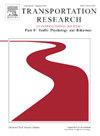Assessment of takeover safety in human–machine co-driving on grassland highways: Coupling effects of non-driving-related tasks and takeover scenarios
IF 3.5
2区 工程技术
Q1 PSYCHOLOGY, APPLIED
Transportation Research Part F-Traffic Psychology and Behaviour
Pub Date : 2025-06-11
DOI:10.1016/j.trf.2025.06.003
引用次数: 0
Abstract
The unique environment of grassland highways offers new opportunities and challenges for human–machine co-driving technology. However, the coupling effects of non-driving-related tasks (NDRTs) and takeover scenarios on takeover safety remain unclear. This study designed a driving takeover simulation test featuring three typical takeover scenarios on grassland highways: a parked vehicle ahead, livestock obstructing the lane, and a ramp vehicle merging. Eye-movement and takeover behavior data were collected as drivers engaged in various NDRTs. Based on the takeover behavior pattern (environmental information perception—situational awareness recovery—takeover operation execution), the study developed an objective evaluation system for takeover safety, considering both visual behavior and takeover performance. The improved criteria importance through intercriteria correlation (CRITIC) method was applied to construct the Takeover Safety Index (TSI), enabling the graded quantitative assessment of takeover safety. The findings indicated that as the sensory involvement dimension of NDRTs increased, drivers’ visual field expanded, requiring more frequent information searches to restore situational awareness. When performing cognitive NDRTs, drivers’ alertness and their takeover reaction abilities improved. However, when NDRTs occupied visual and manual resources, drivers’ takeover performance significantly declined. Additionally, the high dynamics of the ramp vehicle merging scenario shortened drivers’ takeover reaction time but was accompanied by a deterioration in visual perception ability and takeover quality. Coupling effect analysis revealed that drivers’ takeover safety significantly decreased when engaged in watching videos and playing games in this scenario, with the proportion of TSI in the extremely unsafe interval reaching 25% and 35.7%, respectively. This suggests that the occupation of visual and manual resources by NDRTs and the high dynamics of risk obstacles are key factors affecting takeover safety. This study provides theoretical guidance for interventions in takeover behavior and optimization of autonomous driving systems in the human–machine co-driving environment on grassland highways.
草地公路人机协同驾驶接管安全评价:非驾驶相关任务与接管场景的耦合效应
草原公路独特的环境为人机协同驾驶技术提供了新的机遇和挑战。然而,非驾驶相关任务(NDRTs)和接管场景对接管安全的耦合效应尚不清楚。本研究设计了草地高速公路上三种典型接管场景的驾驶接管模拟测试:前方停放车辆、牲畜阻塞车道和匝道车辆合并。在不同的ndrt中采集司机的眼动和接管行为数据。基于接管行为模式(环境信息感知-态势感知恢复-接管操作执行),构建了兼顾视觉行为和接管绩效的接管安全客观评价体系。采用改进的标准间相关性重要度(critical)方法构建收购安全指数(TSI),实现对收购安全的分级定量评价。研究结果表明,随着NDRTs感官参与维度的增加,驾驶员的视野扩大,需要更频繁的信息搜索来恢复情景感知。在进行认知性NDRTs时,驾驶员的警觉性和接管反应能力均有所提高。然而,当NDRTs占用视觉和人工资源时,驾驶员接管性能明显下降。此外,高动态匝道车辆合并场景缩短了驾驶员的接管反应时间,但伴随着视觉感知能力和接管质量的下降。耦合效应分析显示,在该情景下,驾驶员在观看视频和玩游戏时的接管安全性显著降低,处于极度不安全区间的接管安全性分别达到25%和35.7%。这表明NDRTs对视觉和人工资源的占用以及风险障碍的高度动态是影响接管安全的关键因素。本研究为草地高速公路人机协同驾驶环境下自动驾驶系统接管行为干预和优化提供理论指导。
本文章由计算机程序翻译,如有差异,请以英文原文为准。
求助全文
约1分钟内获得全文
求助全文
来源期刊
CiteScore
7.60
自引率
14.60%
发文量
239
审稿时长
71 days
期刊介绍:
Transportation Research Part F: Traffic Psychology and Behaviour focuses on the behavioural and psychological aspects of traffic and transport. The aim of the journal is to enhance theory development, improve the quality of empirical studies and to stimulate the application of research findings in practice. TRF provides a focus and a means of communication for the considerable amount of research activities that are now being carried out in this field. The journal provides a forum for transportation researchers, psychologists, ergonomists, engineers and policy-makers with an interest in traffic and transport psychology.

 求助内容:
求助内容: 应助结果提醒方式:
应助结果提醒方式:


